CDX2-Suppressed Colorectal Cancers Possess Potentially Targetable Alterations in Receptor Tyrosine Kinases and Other Colorectal-Cancer-Associated Pathways
Abstract
1. Introduction
2. Methods
3. Results
3.1. The TCGA Colorectal Cancer Cohort
3.2. The Sidra-LUMC AC-ICAM Cohort
4. Discussion
5. Conclusions
Funding
Institutional Review Board Statement
Informed Consent Statement
Data Availability Statement
Conflicts of Interest
References
- Siegel, R.L.; Giaquinto, A.N.; Jemal, A. Cancer statistics, 2024. CA Cancer. J. Clin. 2024, 74, 12–49. [Google Scholar] [CrossRef] [PubMed]
- Urbute, A.; Sand, F.L.; Belmonte, F.; Iversen, L.H.; Munk, C.; Kjaer, S.K. Trends in rectal cancer incidence, relative survival, and mortality in Denmark during 1978-2018. Eur. J. Cancer. Prev. 2022, 31, 451–458. [Google Scholar] [CrossRef] [PubMed]
- Arnold, M.; Abnet, C.C.; Neale, R.E.; Vignat, J.; Giovannucci, E.L.; McGlynn, K.A.; Bray, F. Global Burden of 5 Major Types of Gastrointestinal Cancer. Gastroenterology 2020, 159, 335–349. [Google Scholar] [CrossRef] [PubMed] [PubMed Central]
- André, T.; Shiu, K.K.; Kim, T.W.; Jensen, B.V.; Jensen, L.H.; Punt, C.; Smith, D.; Garcia-Carbonero, R.; Benavides, M.; Gibbs, P.; et al. KEYNOTE-177 Investigators. Pembrolizumab in Microsatellite-Instability-High Advanced Colorectal Cancer. N. Engl. J. Med. 2020, 383, 2207–2218. [Google Scholar] [CrossRef] [PubMed]
- Yaeger, R.; Weiss, J.; Pelster, M.S.; Spira, A.I.; Barve, M.; Ou, S.I.; Leal, T.A.; Bekaii-Saab, T.S.; Paweletz, C.P.; Heavy, G.A.; et al. Adagrasib with or without Cetuximab in Colorectal Cancer with Mutated KRAS G12C. N. Engl. J. Med. 2023, 388, 44–54. [Google Scholar] [CrossRef] [PubMed] [PubMed Central]
- Kopetz, S.; Grothey, A.; Yaeger, R.; Van Cutsem, E.; Desai, J.; Yoshino, T.; Wasan, H.; Ciardiello, F.; Loupakis, F.; Hong, Y.S.; et al. Encorafenib, Binimetinib, and Cetuximab in BRAF V600E-Mutated Colorectal Cancer. N. Engl. J. Med. 2019, 381, 1632–1643. [Google Scholar] [CrossRef] [PubMed]
- Benson, A.B.; Venook, A.P.; Al-Hawary, M.M.; Arain, M.A.; Chen, Y.J.; Ciombor, K.K.; Cohen, S.; Cooper, H.S.; Deming, D.; Farkas, L.; et al. Colon Cancer, Version 2.2021, NCCN Clinical Practice Guidelines in Oncology. J. Natl. Compr. Cancer Netw. 2021, 19, 329–359. [Google Scholar] [CrossRef] [PubMed]
- Pathak, P.S.; Chan, G.; Deming, D.A.; Chee, C.E. State-of-the-Art Management of Colorectal Cancer: Treatment Advances and Innovation. Am. Soc. Clin. Oncol. Educ. Book 2024, 44, e438466. [Google Scholar] [CrossRef] [PubMed]
- Guinney, J.; Dienstmann, R.; Wang, X.; de Reyniès, A.; Schlicker, A.; Soneson, C.; Marisa, L.; Roepman, P.; Nyamundanda, G.; Angelino, P.; et al. The consensus molecular subtypes of colorectal cancer. Nat. Med. 2015, 21, 1350–1356. [Google Scholar] [CrossRef] [PubMed] [PubMed Central]
- Trinh, A.; Trumpi, K.; De Sousa, E.; Melo, F.; Wang, X.; de Jong, J.H.; Fessler, E.; Kuppen, P.J.; Reimers, M.S.; Swets, M.; et al. Practical and Robust Identification of Molecular Subtypes in Colorectal Cancer by Immunohistochemistry. Clin. Cancer. Res. 2017, 23, 387–398. [Google Scholar] [CrossRef] [PubMed]
- Dalerba, P.; Sahoo, D.; Paik, S.; Guo, X.; Yothers, G.; Song, N.; Wilcox-Fogel, N.; Forgó, E.; Rajendran, P.S.; Miranda, S.P.; et al. CDX2 as a Prognostic Biomarker in Stage II and Stage III Colon Cancer. N. Engl. J. Med. 2016, 374, 211–222. [Google Scholar] [CrossRef] [PubMed] [PubMed Central]
- Cancer Genome Atlas Network. Comprehensive molecular characterization of human colon and rectal cancer. Nature 2012, 487, 330–337. [Google Scholar] [CrossRef] [PubMed] [PubMed Central]
- Roelands, J.; Kuppen, P.J.K.; Ahmed, E.I.; Mall, R.; Masoodi, T.; Singh, P.; Monaco, G.; Raynaud, C.; de Miranda, N.F.C.C.; Ferraro, L.; et al. An integrated tumor, immune and microbiome atlas of colon cancer. Nat. Med. 2023, 29, 1273–1286. [Google Scholar] [CrossRef] [PubMed] [PubMed Central]
- Ellrott, K.; Bailey, M.H.; Saksena, G.; Covington, K.R.; Kandoth, C.; Stewart, C.; Hess, J.; Ma, S.; Chiotti, K.E.; McLellan, M.; et al. Scalable Open Science Approach for Mutation Calling of Tumor Exomes Using Multiple Genomic Pipelines. Cell Syst. 2018, 28, 271–281.e7. [Google Scholar] [CrossRef] [PubMed] [PubMed Central]
- Mermel, C.H.; Schumacher, S.E.; Hill, B.; Meyerson, M.L.; Beroukhim, R.; Getz, G. GISTIC2.0 facilitates sensitive and confident localization of the targets of focal somatic copy-number alteration in human cancers. Genome Biol. 2011, 12, R41. [Google Scholar] [CrossRef] [PubMed] [PubMed Central]
- Cibulskis, K.; Lawrence, M.S.; Carter, S.L.; Sivachenko, A.; Jaffe, D.; Sougnez, C.; Gabriel, S.; Meyerson, M.; Lander, E.S.; Getz, G. Sensitive detection of somatic point mutations in impure and heterogeneous cancer samples. Nat. Biotechnol. 2013, 31, 213–219. [Google Scholar] [CrossRef] [PubMed] [PubMed Central]
- Li, B.; Dewey, C.N. RSEM: Accurate transcript quantification from RNA-Seq data with or without a reference genome. BMC Bioinform. 2011, 12, 323. [Google Scholar] [CrossRef] [PubMed] [PubMed Central]
- Carter, S.L.; Cibulskis, K.; Helman, E.; McKenna, A.; Shen, H.; Zack, T.; Laird, P.W.; Onofrio, R.C.; Winckler, W.; Weir, B.A.; et al. Absolute quantification of somatic DNA alterations in human cancer. Nat. Biotechnol. 2012, 30, 413–421. [Google Scholar] [CrossRef] [PubMed] [PubMed Central]
- Cerami, E.; Gao, J.; Dogrusoz, U.; Gross, B.E.; Sumer, S.O.; Aksoy, B.A.; Jacobsen, A.; Byrne, C.J.; Heuer, M.L.; Larsson, E.; et al. The cBio cancer genomics portal: An open platform for exploring multidimensional cancer genomics data. Cancer Discov. 2012, 2, 401–404. [Google Scholar] [CrossRef] [PubMed] [PubMed Central]
- Gao, J.; Aksoy, B.A.; Dogrusoz, U.; Dresdner, G.; Gross, B.; Sumer, S.O.; Sun, Y.; Jacobsen, A.; Sinha, R.; Larsson, E.; et al. Integrative analysis of complex cancer genomics and clinical profiles using the cBioPortal. Sci. Signal. 2013, 6, l1. [Google Scholar] [CrossRef] [PubMed] [PubMed Central]
- Chakravarty, D.; Gao, J.; Phillips, S.M.; Kundra, R.; Zhang, H.; Wang, J.; Rudolph, J.E.; Yaeger, R.; Soumerai, T.; Nissan, M.H.; et al. OncoKB: A Precision Oncology Knowledge Base. JCO Precis. Oncol. 2017, 1, 1–16. [Google Scholar] [CrossRef] [PubMed] [PubMed Central]
- Coskun, M.; Troelsen, J.T.; Nielsen, O.H. The role of CDX2 in intestinal homeostasis and inflammation. Biochim. Biophys. Acta 2011, 1812, 283–289. [Google Scholar] [CrossRef] [PubMed]
- Freund, J.N.; Duluc, I.; Reimund, J.M.; Gross, I.; Domon-Dell, C. Extending the functions of the homeotic transcription factor Cdx2 in the digestive system through nontranscriptional activities. World J. Gastroenterol. 2015, 21, 1436–1443. [Google Scholar] [CrossRef] [PubMed] [PubMed Central]
- Silberg, D.G.; Swain, G.P.; Suh, E.R.; Traber, P.G. Cdx1 and cdx2 expression during intestinal development. Gastroenterology 2000, 119, 961–971. [Google Scholar] [CrossRef] [PubMed]
- Badia-Ramentol, J.; Gimeno-Valiente, F.; Duréndez, E.; Martínez-Ciarpaglini, C.; Linares, J.; Iglesias, M.; Cervantes, A.; Calon, A.; Tarazona, N. The prognostic potential of CDX2 in colorectal cancer: Harmonizing biology and clinical practice. Cancer Treat. Rev. 2023, 121, 102643. [Google Scholar] [CrossRef] [PubMed]
- Bellizzi, A.M. An Algorithmic Immunohistochemical Approach to Define Tumor Type and Assign Site of Origin. Adv. Anat. Pathol. 2020, 27, 114–163. [Google Scholar] [CrossRef] [PubMed] [PubMed Central]
- Hinoi, T.; Gesina, G.; Akyol, A.; Kuick, R.; Hanash, S.; Giordano, T.J.; Gruber, S.B.; Fearon, E.R. CDX2-regulated expression of iron transport protein hephaestin in intestinal and colonic epithelium. Gastroenterology 2005, 128, 946–961. [Google Scholar] [CrossRef] [PubMed]
- Li, J.; Zeng, Q.; Lin, J.; Huang, H.; Chen, L. Loss of SATB2 and CDX2 expression is associated with DNA mismatch repair protein deficiency and BRAF mutation in colorectal cancer. Med. Mol. Morphol. 2024, 57, 1–10. [Google Scholar] [CrossRef] [PubMed]
- Yang, L.; Tu, L.; Bisht, S.; Mao, Y.; Petkovich, D.; Thursby, S.J.; Liang, J.; Patel, N.; Yen, R.C.; Largent, T.; et al. Tissue-location-specific transcription programs drive tumor dependencies in colon cancer. Nat. Commun. 2024, 15, 1384. [Google Scholar] [CrossRef] [PubMed]
- Mauri, G.; Arena, S.; Siena, S.; Bardelli, A.; Sartore-Bianchi, A. The DNA damage response pathway as a land of therapeutic opportunities for colorectal cancer. Ann. Oncol. 2020, 31, 1135–1147. [Google Scholar] [CrossRef] [PubMed]
- Durinikova, E.; Reilly, N.M.; Buzo, K.; Mariella, E.; Chilà, R.; Lorenzato, A.; Dias, J.M.L.; Grasso, G.; Pisati, F.; Lamba, S.; et al. Targeting the DNA Damage Response Pathways and Replication Stress in Colorectal Cancer. Clin. Cancer Res. 2022, 28, 3874–3889. [Google Scholar] [CrossRef] [PubMed]
- Zhong, Z.A.; Michalski, M.N.; Stevens, P.D.; Sall, E.A.; Williams, B.O. Regulation of Wnt receptor activity: Implications for therapeutic development in colon cancer. J. Biol. Chem. 2021, 296, 100782. [Google Scholar] [CrossRef] [PubMed] [PubMed Central]
- Solberg, N.T.; Waaler, J.; Lund, K.; Mygland, L.; Olsen, P.A.; Krauss, S. TANKYRASE Inhibition Enhances the Antiproliferative Effect of PI3K and EGFR Inhibition, Mutually Affecting β-CATENIN and AKT Signaling in Colorectal Cancer. Mol. Cancer Res. 2018, 16, 543–553. [Google Scholar] [CrossRef] [PubMed]
- Farnhammer, F.; Colozza, G.; Kim, J. RNF43 and ZNRF3 in Wnt Signaling—A Master Regulator at the Membrane. Int. J. Stem Cells 2023, 16, 376–384. [Google Scholar] [CrossRef] [PubMed] [PubMed Central]
- Seeber, A.; Battaglin, F.; Zimmer, K.; Kocher, F.; Baca, Y.; Xiu, J.; Spizzo, G.; Novotny-Diermayr, V.; Rieder, D.; Puccini, A.; et al. Comprehensive Analysis of R-Spondin Fusions and RNF43 Mutations Implicate Novel Therapeutic Options in Colorectal Cancer. Clin. Cancer Res. 2022, 28, 1863–1870. [Google Scholar] [CrossRef] [PubMed] [PubMed Central]
- Elez, E.; Ros, J.; Fernández, J.; Villacampa, G.; Moreno-Cárdenas, A.B.; Arenillas, C.; Bernatowicz, K.; Comas, R.; Li, S.; Kodack, D.P.; et al. RNF43 mutations predict response to anti-BRAF/EGFR combinatory therapies in BRAFV600E metastatic colorectal cancer. Nat. Med. 2022, 28, 2162–2170. [Google Scholar] [CrossRef] [PubMed] [PubMed Central]
- Voutsadakis, I.A. Molecular Alterations and Putative Therapeutic Targeting of Planar Cell Polarity Proteins in Breast Cancer. J. Clin. Med. 2023, 12, 411. [Google Scholar] [CrossRef] [PubMed] [PubMed Central]
- Yue, F.; Ku, A.T.; Stevens, P.D.; Michalski, M.N.; Jiang, W.; Tu, J.; Shi, Z.; Dou, Y.; Wang, Y.; Feng, X.H.; et al. Loss of ZNRF3/RNF43 Unleashes EGFR in Cancer. bioRxiv 2024, preprint. [Google Scholar] [CrossRef] [PubMed] [PubMed Central]
- Goh, L.K.; Sorkin, A. Endocytosis of receptor tyrosine kinases. Cold Spring Harb. Perspect. Biol. 2013, 5, a017459. [Google Scholar] [CrossRef] [PubMed] [PubMed Central]
- Chan, W.Y.; Chua, W.; Wilkinson, K.; Epitakaduwa, C.; Mandaliya, H.; Descallar, J.; Roberts, T.L.; Becker, T.M.; Ng, W.; Lee, C.S.; et al. The Prognostic and Predictive Utility of CDX2 in Colorectal Cancer. Int. J. Mol. Sci. 2024, 25, 8673. [Google Scholar] [CrossRef] [PubMed] [PubMed Central]
- Pilati, C.; Taieb, J.; Balogoun, R.; Marisa, L.; de Reyniès, A.; Laurent-Puig, P. CDX2 prognostic value in stage II/III resected colon cancer is related to CMS classification. Ann. Oncol. 2017, 28, 1032–1035. [Google Scholar] [CrossRef] [PubMed]

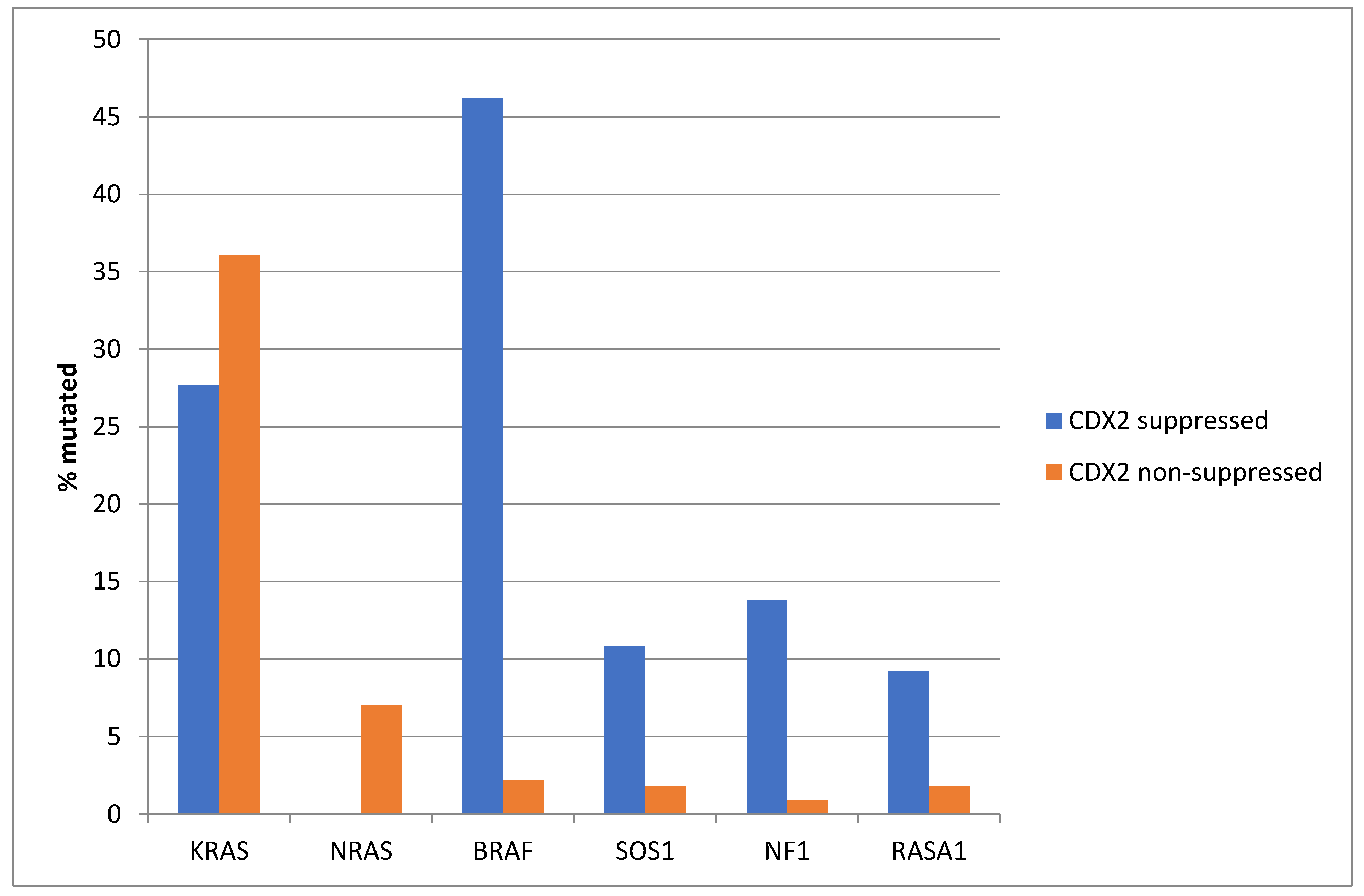

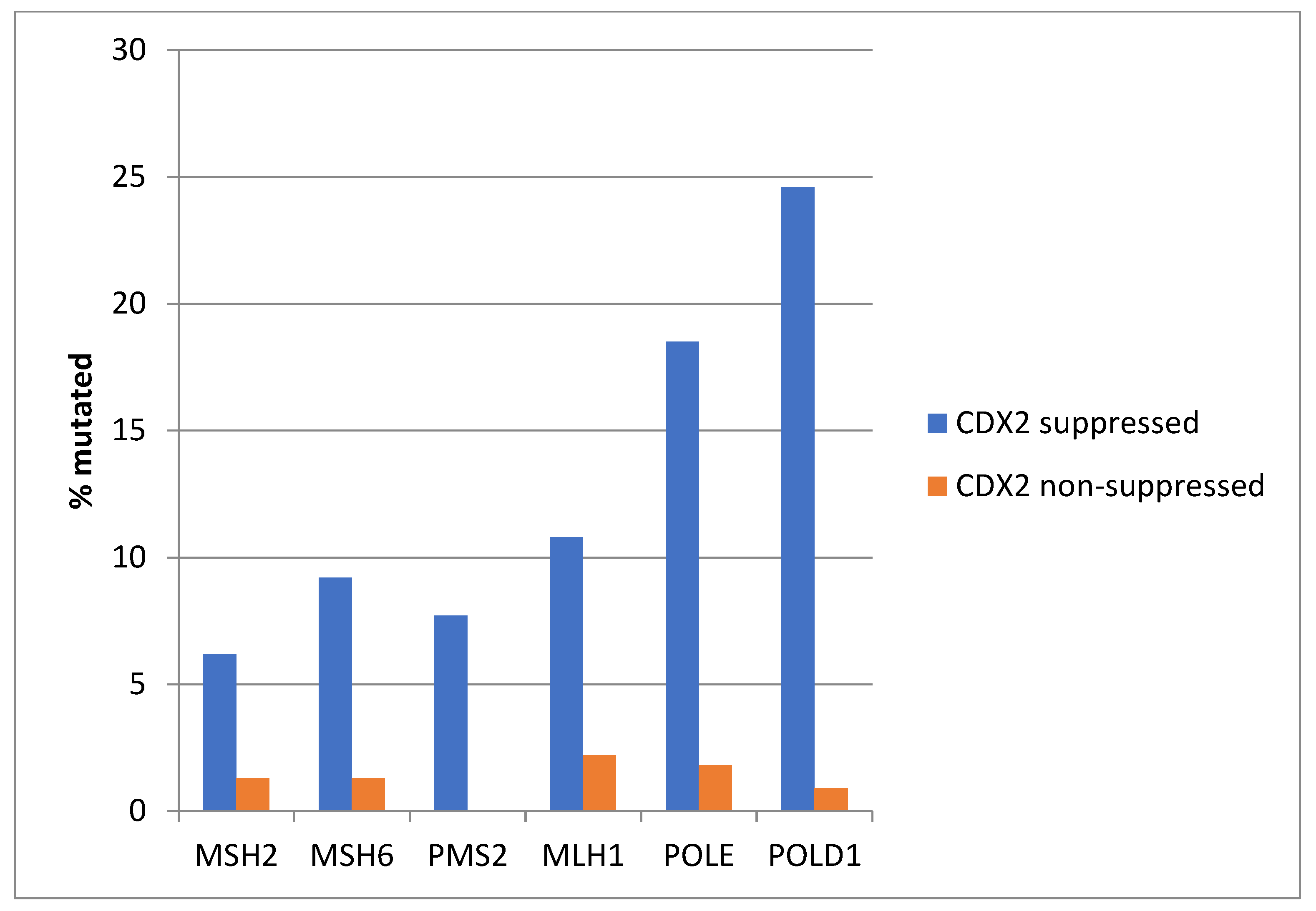
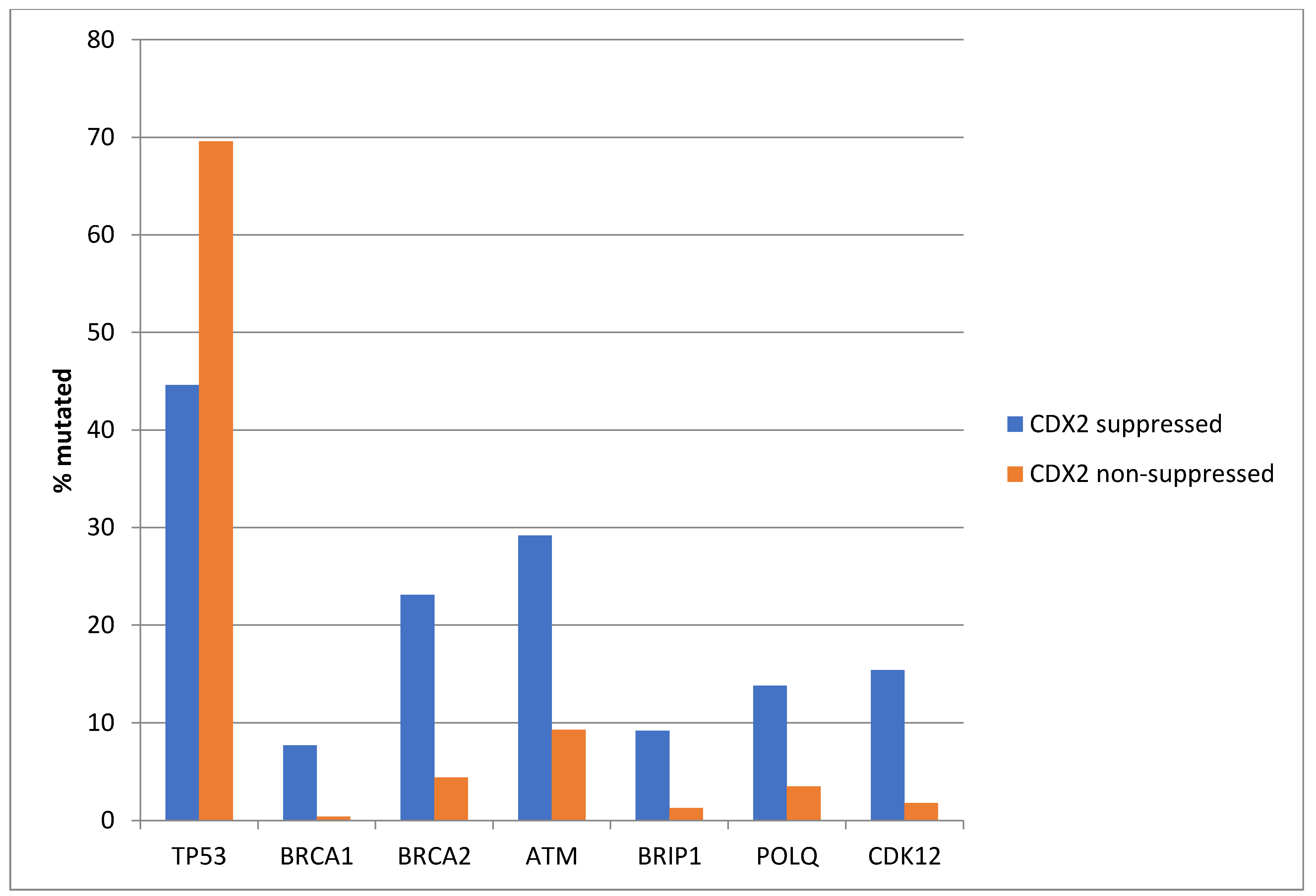
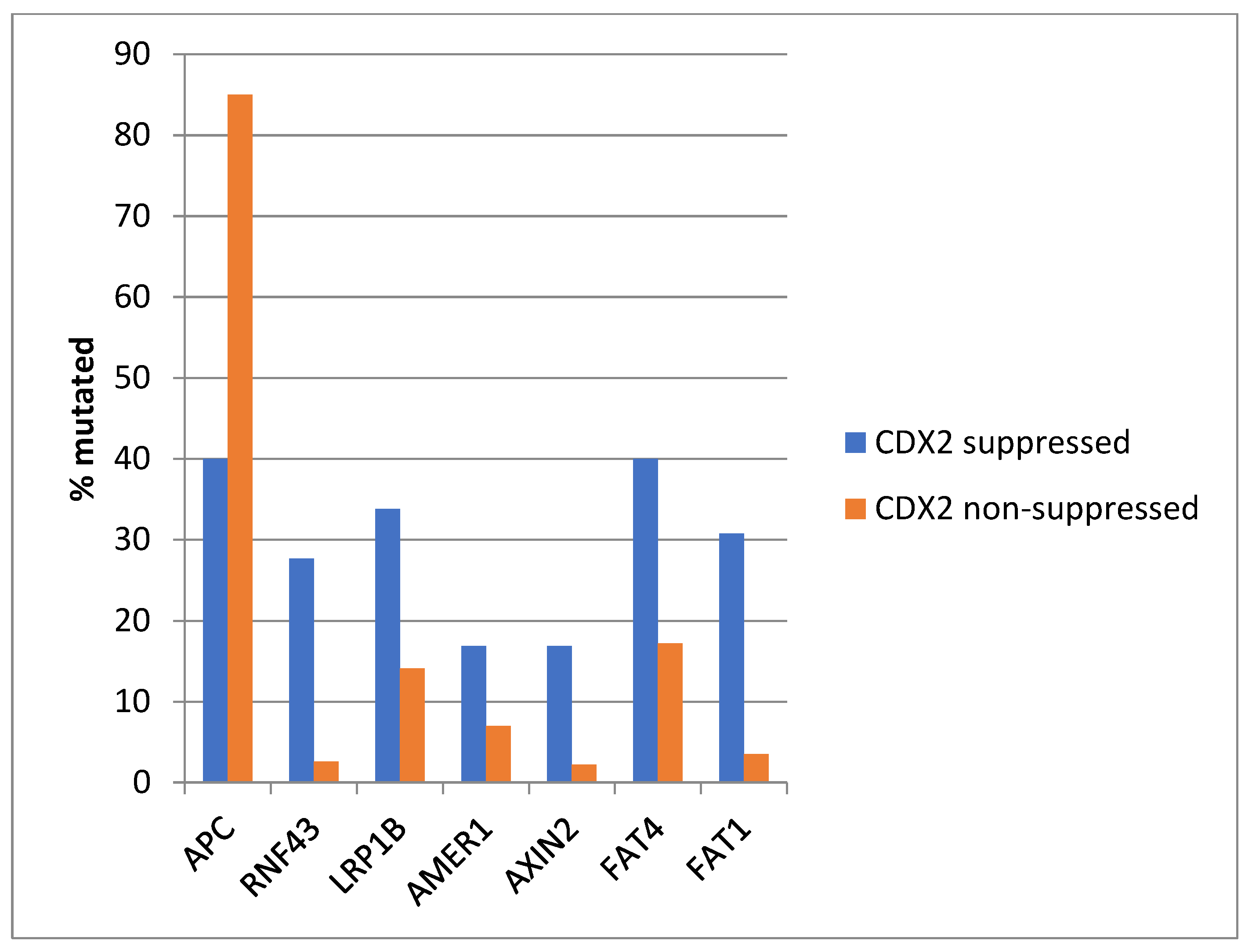
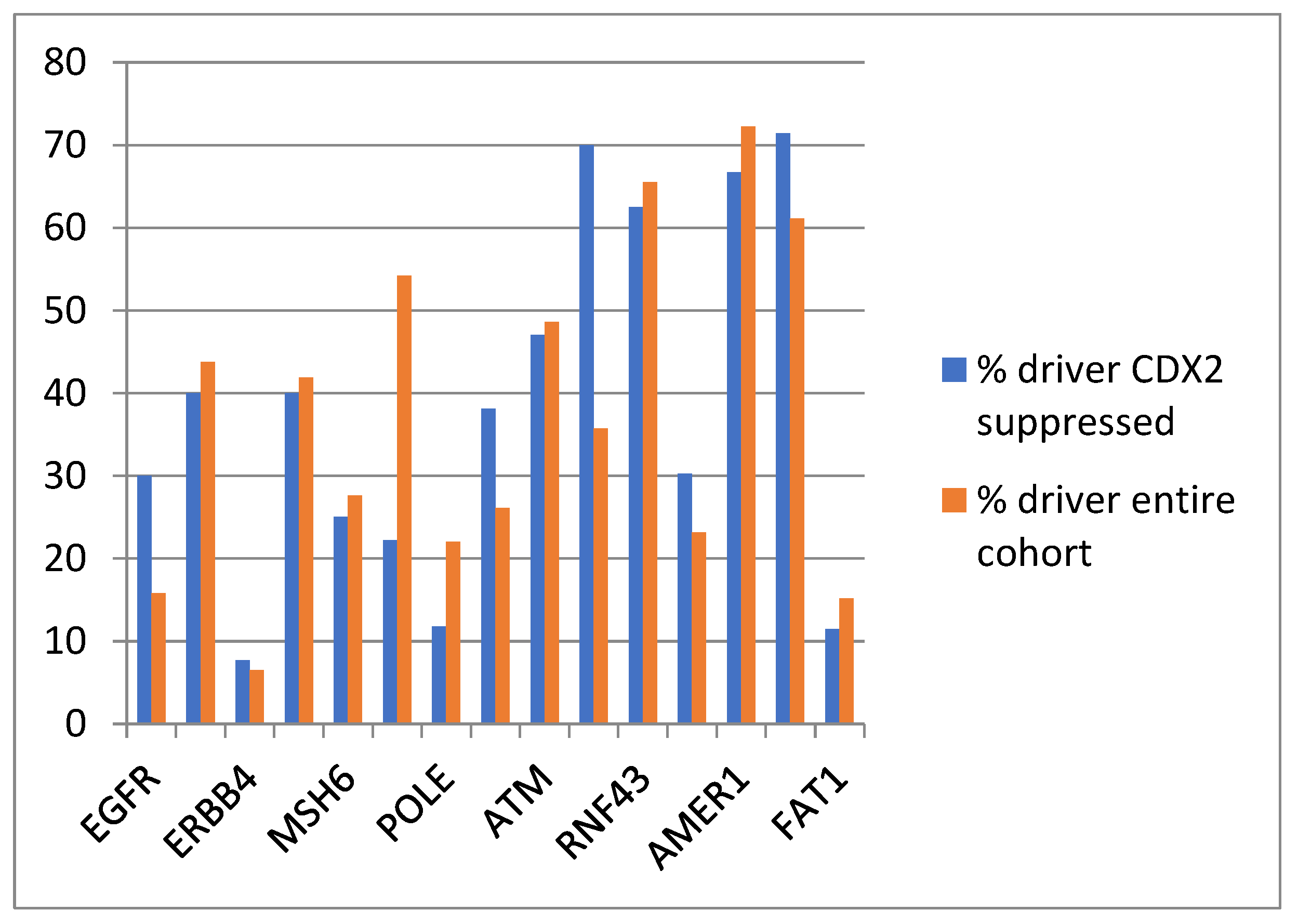

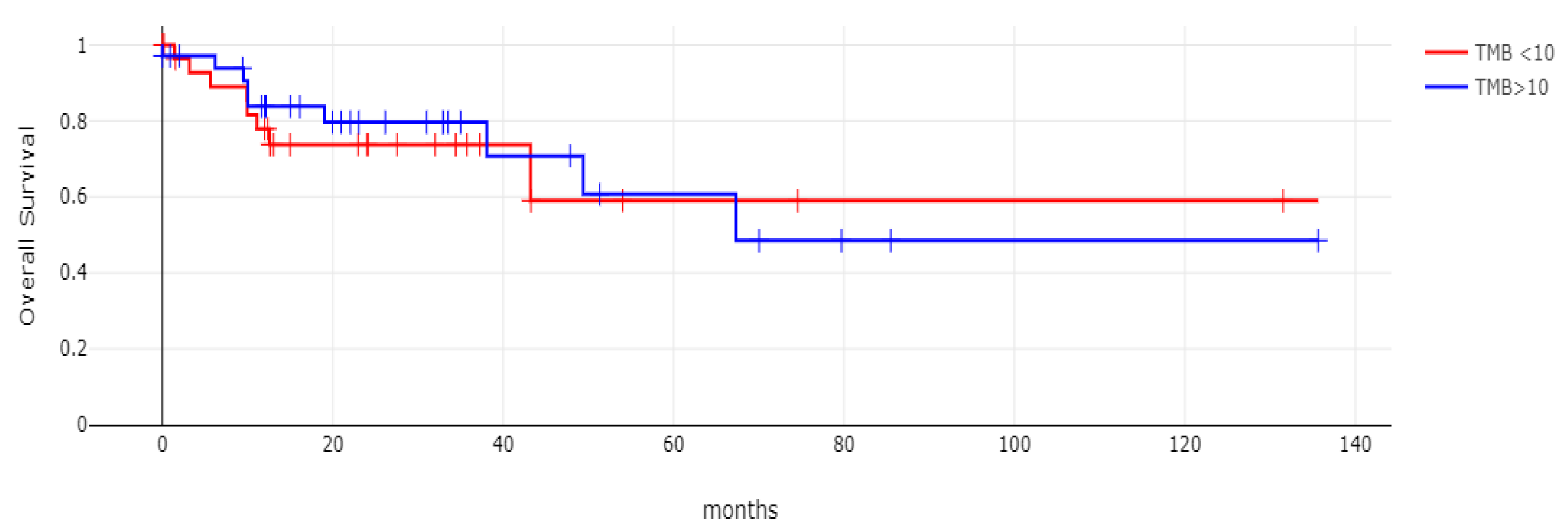
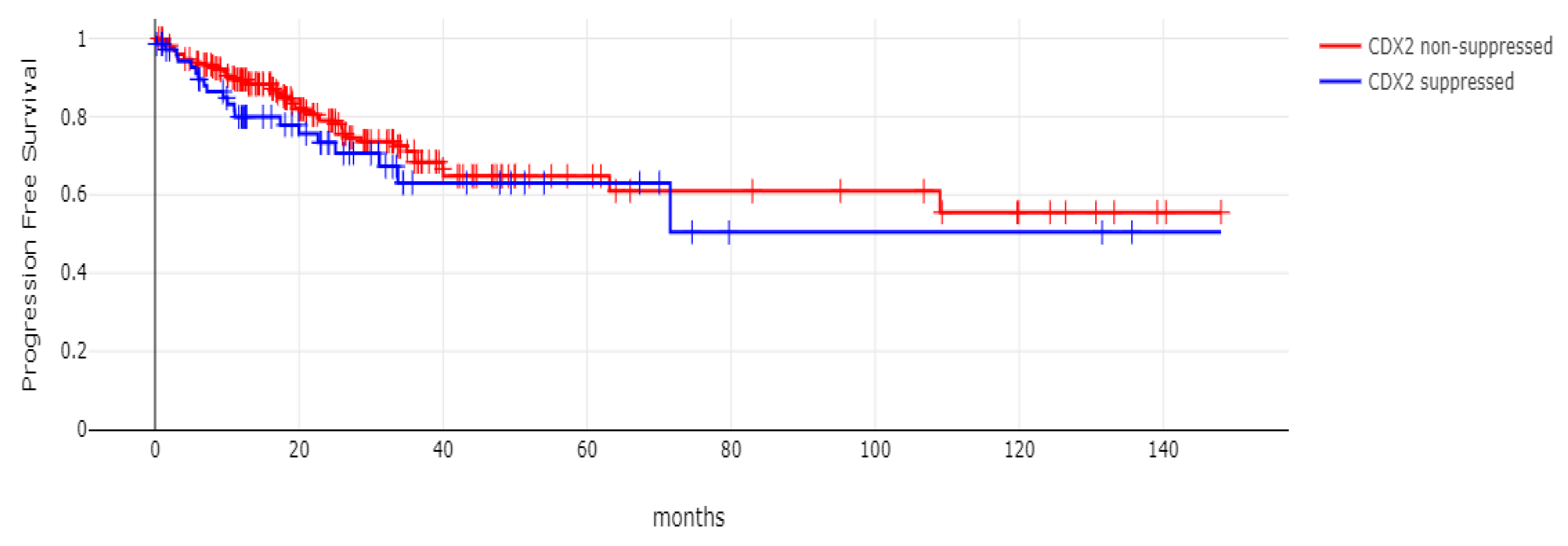
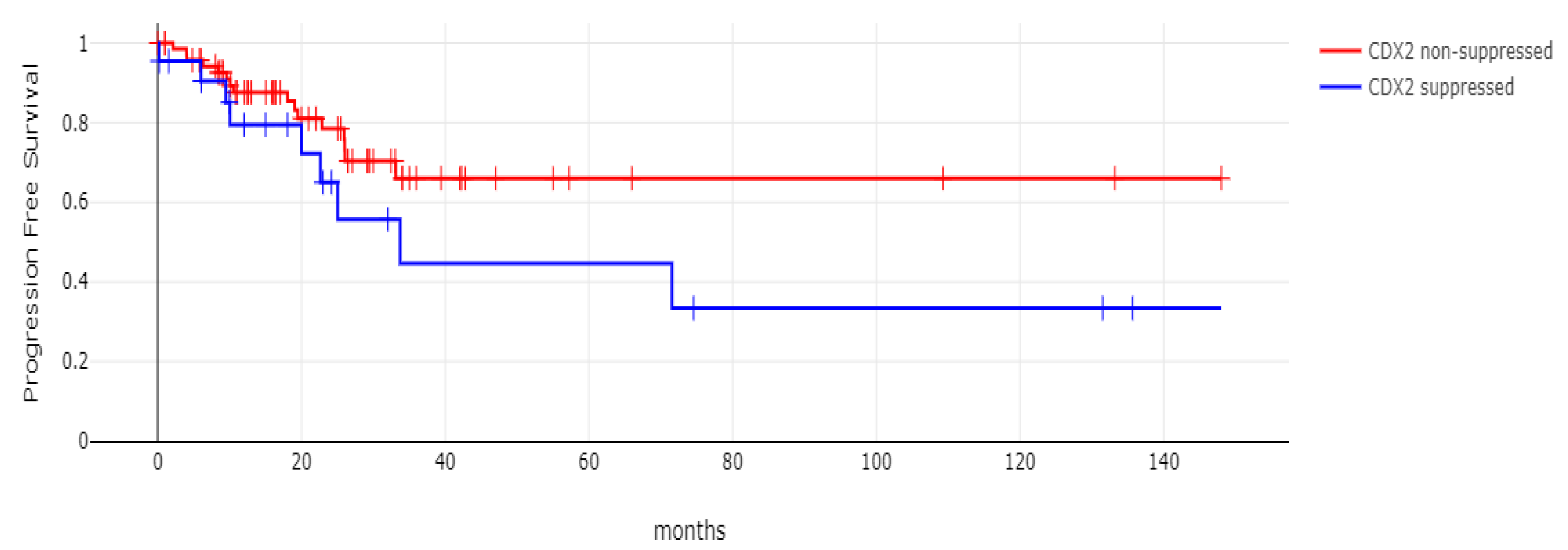


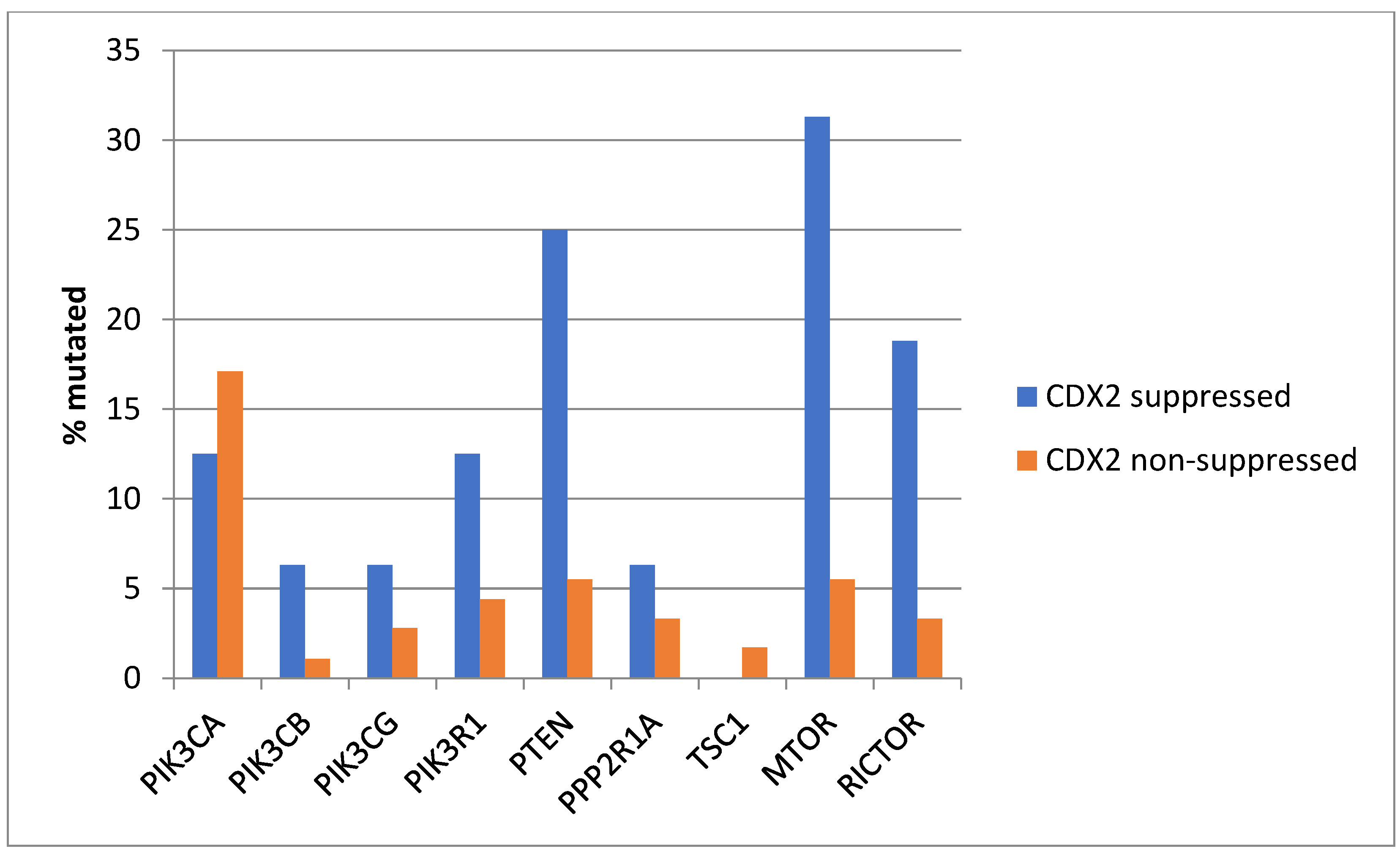
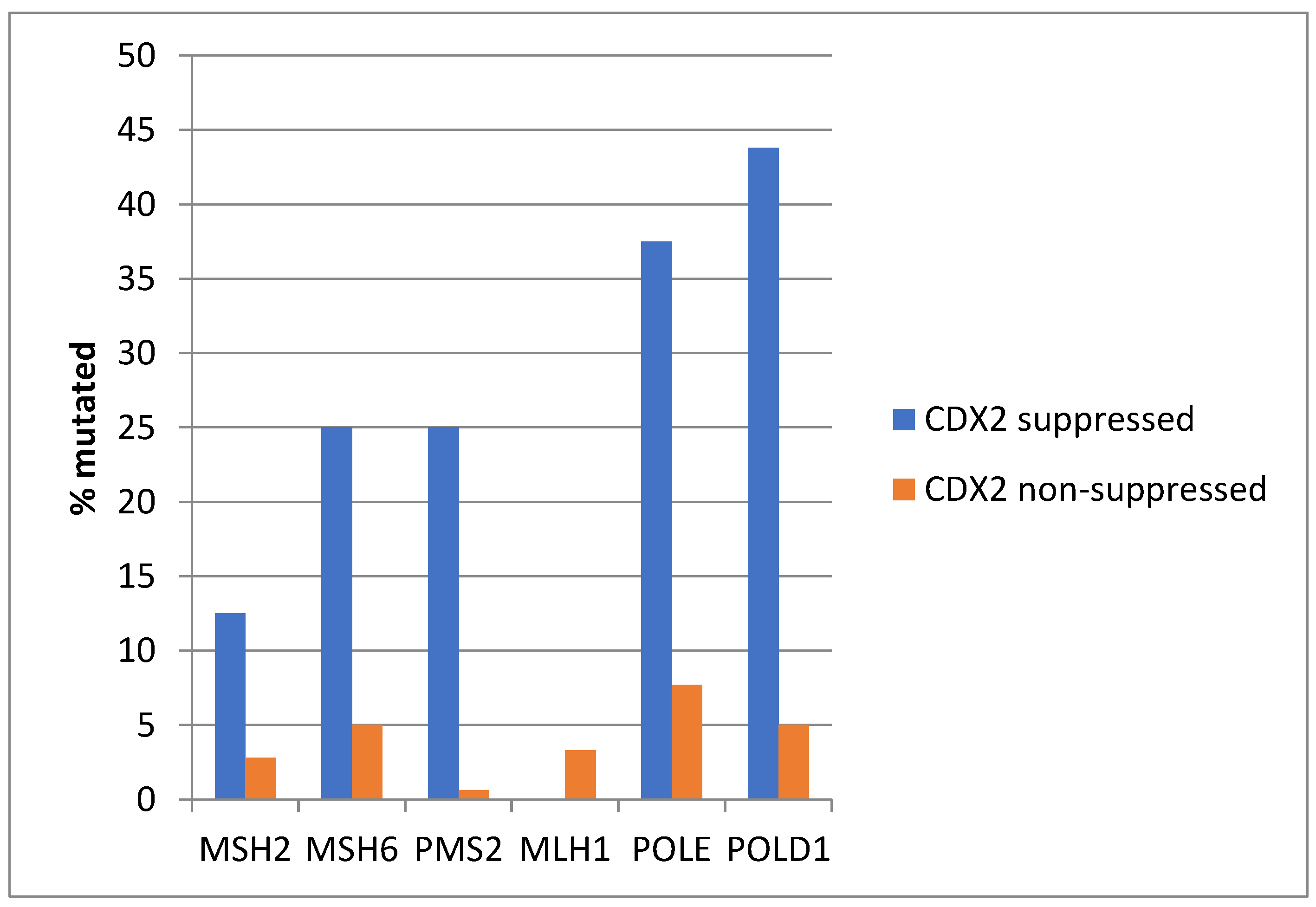
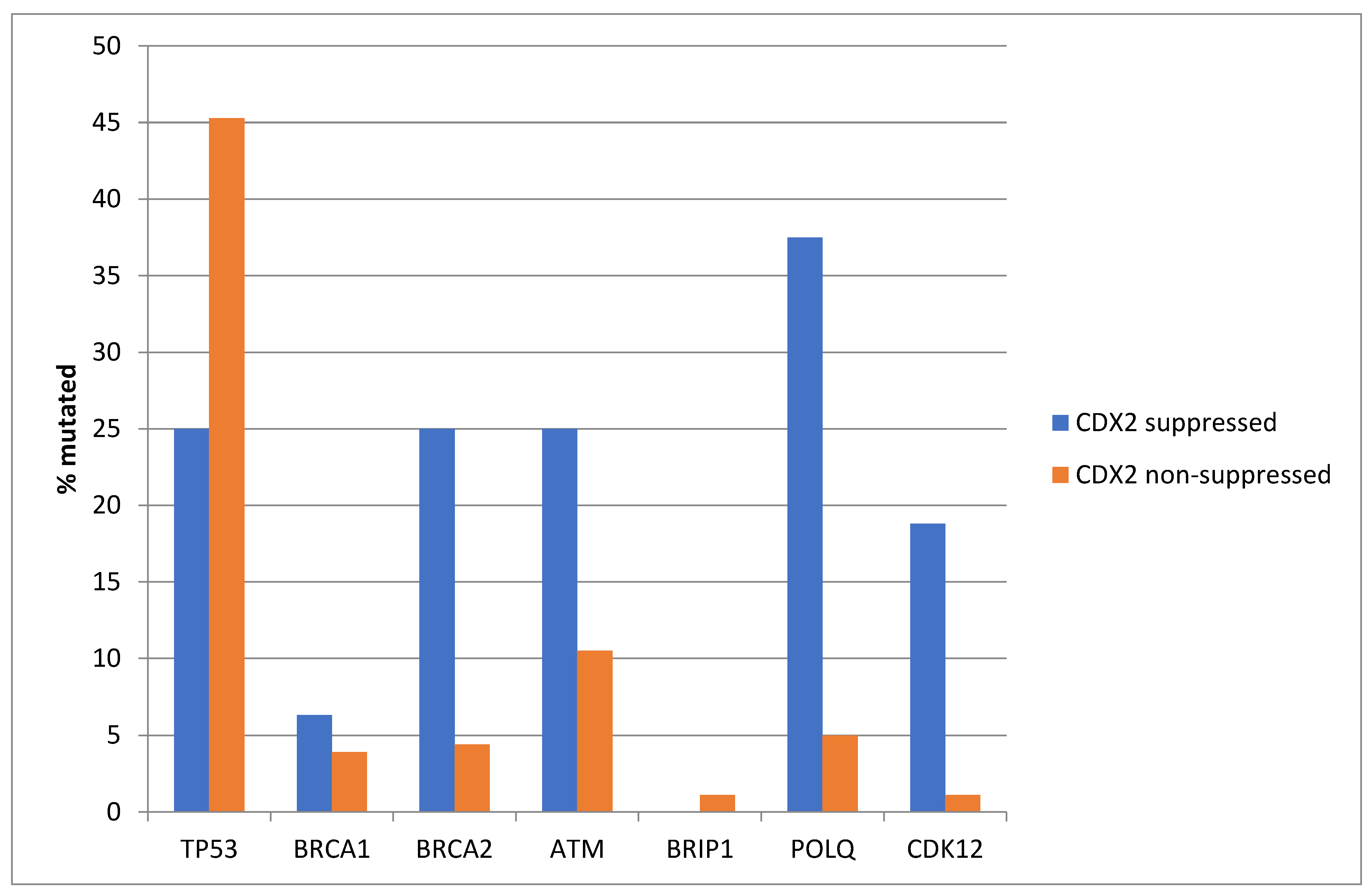
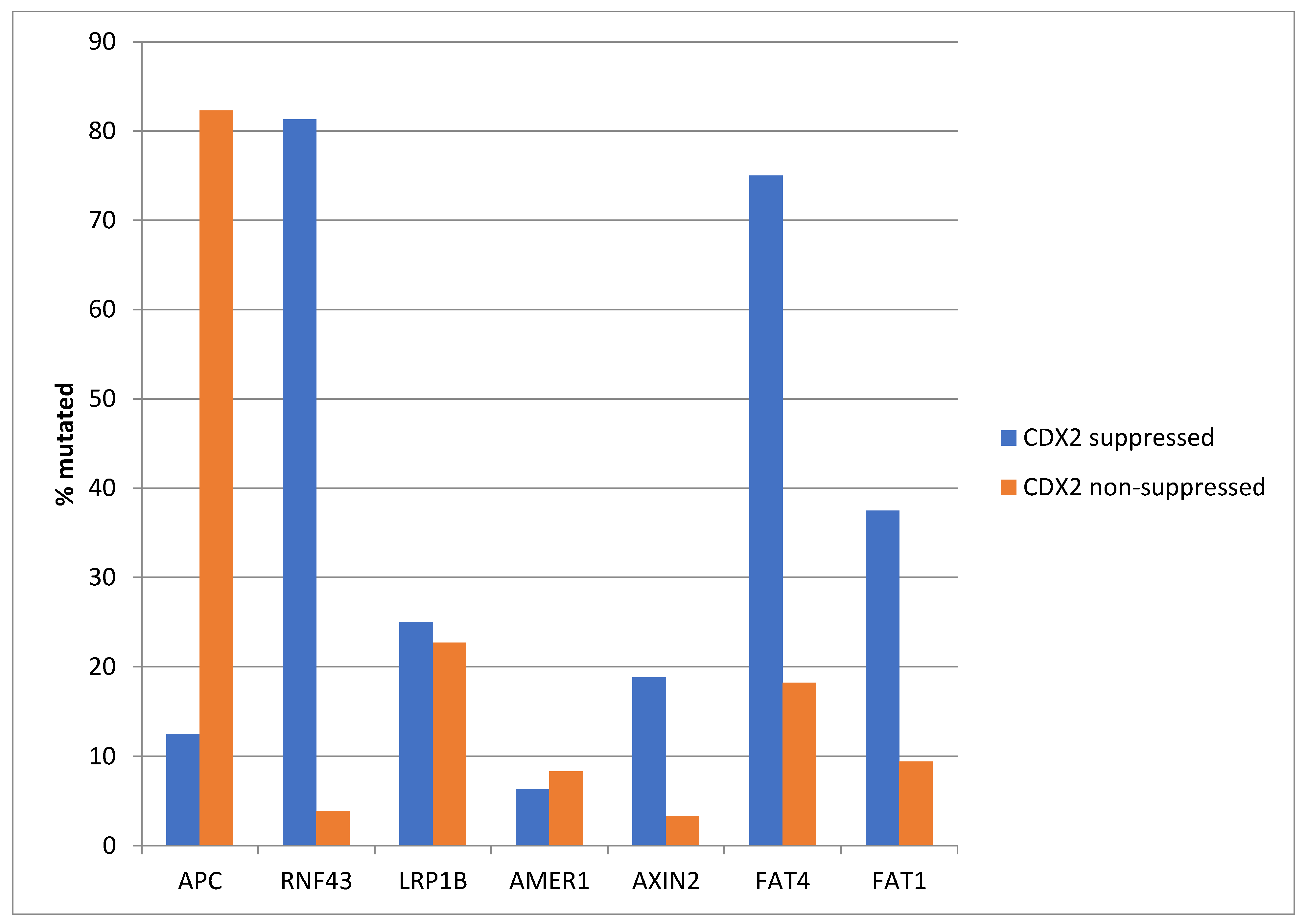
| Characteristic | Entire Cohort (n = 594) | CDX2 Suppressed (n = 75) | Non CDX2 Suppressed (n = 249) | p |
|---|---|---|---|---|
| Age (mean +/− SD) | 66.1 +/− 13.4 | 64.4 +/− 15.3 | 66.6 +/− 12.5 | 0.2 |
| Age | ||||
| ≤65 years-old | 260 (43.9) | 36 (48) | 106 (42.7) | 0. 42 |
| >65 years-old | 332 (56.1) | 39 (52) | 142 (57.3) | |
| NA | 2 | 1 | ||
| Sex | ||||
| Male | 312 (52.7) | 36 (48) | 139 (56) | 0. 23 |
| Female | 280 (47.3) | 39 (52) | 109 (44) | |
| NA | 2 | 1 | ||
| stage | ||||
| I | 104 (17.9) | 7 (9.6) | 40 (16.4) | I–II versus III–IV |
| II | 220 (37.9) | 36 (49.3) | 90 (36.9) | 0.35 |
| III | 170 (29.3) | 22 (30.1) | 74 (30.3) | |
| IV | 86 (14.8) | 8 (11) | 40 (16.4) | |
| NA | 14 | 2 | 5 | |
| Location primary | ||||
| Colon | 436 (74.1) | 66 (88) | 174 (69.9) | 0.001 |
| Rectal | 152 (25.9) | 9 (12) | 75 (30.1) | |
| NA | 6 |
| Characteristic | Entire Cohort (n = 594) | CDX2 Suppressed (n = 75) | Non CDX2 Suppressed (n = 249) | p |
|---|---|---|---|---|
| Subtype | ||||
| GS | 58 (12.7) | 3 (4.9) | 20 (10) | GS versus CIN versus MSI |
| CIN | 328 (71.4) | 23 (37.8) | 176 (88) | <0.0001 |
| MSI | 63 (13.7) | 33 (54.1) | 3 (1.5) | |
| POLE | 10 (2.2) | 2 (3.2) | 1 (0.5) | |
| NA | 135 | 14 | 49 | |
| TMB | ||||
| ≤10 | 451 | 30 (46.2) | 219 (96.5) | <0.0001 |
| >10 | 83 | 35 (53.8) | 8 (3.5) | |
| NA | 60 | 10 | 22 | |
| AS | ||||
| <4 | 108 (18.4) | 34 (45.9) | 16 (6.5) | <0.0001 |
| 4–24 | 427 (72.9) | 36 (48.7) | 211 (85.1) | |
| >24 | 51 (8.7) | 4 (5.4) | 21 (8.4) | |
| NA | 8 | 1 | 1 | |
| FGA | ||||
| <0.08 | 118 (20.2) | 19 (25.3) | 15 (6.1) | <0.0001 |
| 0.08–0.35 | 316 (54.2) | 44 (58.7) | 77 (31.6) | |
| >0.35 | 149 (25.6) | 12 (16) | 152 (62.3) | |
| NA | 11 | 5 |
| Gene | Entire Cohort (n = 594) (%) | Putative Drivers (%) | CDX2 Suppressed (n = 75) (%) | Putative Drivers (%) | p |
|---|---|---|---|---|---|
| EGFR | 19 (3.2) | 3 (0.5) | 10 (13.3) | 3 (4) | 0.34 |
| ERBB3 | 32 (5.4) | 14 (2.4) | 10 (13.3) | 4 (5.3) | 1 |
| ERBB4 | 62 (10.4) | 4 (0.7) | 13 (17.3) | 1 (1.3) | 1 |
| FGFR2 | 22 (3.7) | 2 (0.3) | 11 (14.7) | 1 (1.3) | 1 |
| FGFR3 | 18 (3) | 1 (0.2) | 6 (8) | 0 | 1 |
| RET | 30 (5.1) | 2 (0.3) | 12 (16) | 2 (2.7) | 0.56 |
| ALK | 41 (6.9) | 1 (0.2) | 14 (18.7) | 0 | 1 |
| NTRK3 | 29 (4.9) | 3 (0.5) | 9 (12) | 1 (1.3) | 1 |
| BRAF | 67 (11.3) | 56 (9.4) | 33 (44) | 30 (40) | 0.37 |
| NF1 | 43 (7.2) | 18 (3) | 15 (20) | 6 (8) | 1 |
| RASA1 | 29 (4.9) | 8 (1.3) | 10 (13.3) | 1 (1.3) | 0.39 |
| PIK3CB | 16 (2.7) | 2 (0.3) | 3 (4) | 0 | 1 |
| PIK3R1 | 38 (6.4) | 29 (4.9) | 11 (14.7) | 9 (12) | 1 |
| PTEN | 48 (8.1) | 46 (7.7) | 15 (20) | 15 (20) | 1 |
| PPP2R1A | 15 (2.5) | 6 (1) | 6 (8) | 2 (2.7) | 1 |
| TSC1 | 21 (3.5) | 7 (1.2) | 11 (14.7) | 6 (8) | 0.28 |
| MTOR | 46 (7.7) | 5 (0.8) | 14 (18.7) | 0 | 0.32 |
| MSH2 | 27 (4.5) | 10 (1.7) | 7 (9.3) | 4 (5.3) | 0.41 |
| MSH6 | 29 (4.9) | 8 (1.3) | 8 (10.7) | 2 (2.7) | 1 |
| PMS2 | 16 (2.7) | 4 (0.7) | 6 (8) | 1 (1.3) | 1 |
| MLH1 | 24 (4) | 13 (2.2) | 9 (12) | 2 (2.7) | 0.13 |
| POLE | 50 (8.4) | 11 (1.9) | 17 (22.7) | 2 (2.7) | 0.48 |
| BRCA1 | 19 (3.2) | 5 (0.8) | 5 (6.7) | 2 (2.7) | 0.6 |
| BRCA2 | 69 (11.6) | 18 (3) | 21 (28) | 8 (10.7) | 0.28 |
| ATM | 107 (18) | 52(8.8) | 34 (45.3) | 16 (21.3) | 1 |
| BRIP1 | 25 (4.2) | 4 (0.7) | 7 (9.3) | 1 (1.3) | 1 |
| CDK12 | 42 (7.1) | 15 (2.5) | 10 (13.3) | 7 (9.3) | 0.07 |
| RNF43 | 58 (9.8) | 38 (6.4) | 24 (32) | 15 (20) | 0.8 |
| LRP1B | 190 (32) | 44 (7.4) | 43 (57.3) | 13 (17.3) | 0.33 |
| AMER1 | 72 (12.1) | 52 (8.8) | 12 (16) | 8 (10.7) | 0.73 |
| AXIN2 | 36 (6.1) | 22 (3.7) | 14 (18.7) | 10 (13.3) | 0.74 |
| FAT1 | 99 (16.7) | 15 (2.5) | 35 (46.7) | 4 (5.3) | 0.77 |
| Characteristic | Entire Cohort (n = 348) | CDX2 Suppressed (n = 21) | Non CDX2 Suppressed (n = 219) | p |
|---|---|---|---|---|
| Age | ||||
| Mean (±SD) | 68.2 ± 11.5 | 72.3 ± 9.5 | 68.4 ± 10.7 | 0.1 |
| >65 years old | 233 (67) | 15 (71.4) | 151 (68.9) | 1 |
| ≤65 years old | 115 (33) | 6 (28.6) | 68 (31.1) | |
| Gender | ||||
| Male | 182 (52.3) | 5 (23.8) | 123 (56.2) | 0.005 |
| Female | 166 (47.7) | 16 (76.2) | 96 (43.8) | |
| Stage | ||||
| I | 55 (15.8) | 0 | 46 (21) | |
| II | 122 (35.1) | 8 (38.1) | 69 (31.5) | 1 (Stage I–III versus IV) |
| III | 110 (31.6) | 9 (42.9) | 65 (29.7) | |
| IV | 61 (17.5) | 4 (19) | 39 (17.8) | |
| Primary location | ||||
| Cecum-ascending colon–hepatic flexure | 158 (45.4) | 17 (81) | 95 (43.4) | 0.001 |
| Transverse colon–splenic flexure-descending colon–sigmoid | 190 (54.6) | 4 (19) | 124 (56.6) | |
| Consensus Mol Subtype | ||||
| CMS1 | 43 (12.4) | 14 (66.7) | 5 (2.3) | <0.0001 |
| CMS2 | 76 (21.8) | 0 | 74 (33.8) | |
| CMS3 | 66 (19) | 0 | 52 (23.7) | |
| CMS4 | 82 (23.6) | 6 (28.6) | 40 (18.3) | |
| Mixed | 81 (23.3) | 1 (4.8) | 48 (21.9) | |
| FGA | ||||
| ≤0.08 | 88 (31.3) | 11(68.8) | 38 (21) | 0.0001 |
| >0.08 | 193 (68.7) | 5 (31.2) | 143 (79) | |
| NA | 67 | 5 | 38 | |
| TMB | ||||
| ≤10 mutations/Mb | 208 (74) | 3 (18.7) | 160 (88.4) | 0.0001 |
| >10 mutations/Mb | 73 (26) | 13 (81.3) | 21 (11.6) | |
| NA | 67 | 5 | 38 | |
Disclaimer/Publisher’s Note: The statements, opinions and data contained in all publications are solely those of the individual author(s) and contributor(s) and not of MDPI and/or the editor(s). MDPI and/or the editor(s) disclaim responsibility for any injury to people or property resulting from any ideas, methods, instructions or products referred to in the content. |
© 2024 by the author. Licensee MDPI, Basel, Switzerland. This article is an open access article distributed under the terms and conditions of the Creative Commons Attribution (CC BY) license (https://creativecommons.org/licenses/by/4.0/).
Share and Cite
Voutsadakis, I.A. CDX2-Suppressed Colorectal Cancers Possess Potentially Targetable Alterations in Receptor Tyrosine Kinases and Other Colorectal-Cancer-Associated Pathways. Diseases 2024, 12, 234. https://doi.org/10.3390/diseases12100234
Voutsadakis IA. CDX2-Suppressed Colorectal Cancers Possess Potentially Targetable Alterations in Receptor Tyrosine Kinases and Other Colorectal-Cancer-Associated Pathways. Diseases. 2024; 12(10):234. https://doi.org/10.3390/diseases12100234
Chicago/Turabian StyleVoutsadakis, Ioannis A. 2024. "CDX2-Suppressed Colorectal Cancers Possess Potentially Targetable Alterations in Receptor Tyrosine Kinases and Other Colorectal-Cancer-Associated Pathways" Diseases 12, no. 10: 234. https://doi.org/10.3390/diseases12100234
APA StyleVoutsadakis, I. A. (2024). CDX2-Suppressed Colorectal Cancers Possess Potentially Targetable Alterations in Receptor Tyrosine Kinases and Other Colorectal-Cancer-Associated Pathways. Diseases, 12(10), 234. https://doi.org/10.3390/diseases12100234






